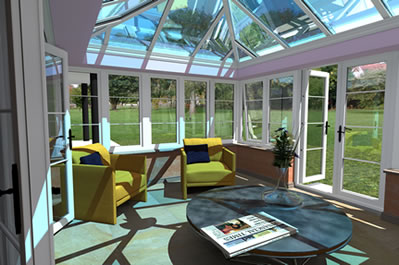Building Your Own Orangery
Building an orangery onto your home can really change how your home feels. It can add light, space and life to where you spend the majority of your time. So what goes into building your orangery? Can you do it yourself?
Here we’ll go through the steps that you need to go through in order to build yourself your own orangery.
Design

Design is your first hurdle as it encompasses both aspirational and practical elements of your wants from an orangery. Theoretically, what do you want and practically what can you build – within budget, planning permission, and time restrictions.
The best way to design an orangery is in computer 3D modelling software. We find that it gives our clients the best indication of size, lighting and the practicalities of the orangery. Clients of ours often want to see multiple variations with different glazing combinations, roof lantern positions and door types, so 3D modelling it gives the best flexibility to see exactly what you want.
Once you’ve got your theoretical design together. It’s time to get actual building plans together from which you can apply for planning permission and pass on to builders for construction. If you’re not hiring an orangery designer and architect, you’re going to need to be familiar with CAD software, in order to produce architect level scale drawings.
Alternatively, you can source and speak to an individual architect who is able to design and draw an orangery to your specification. This in itself can be a complicated process, as finding an architect who can design exactly what you’re looking for can be time consuming and expensive.
Planning Permission

Once you’re happy with your designs and they are completed, you may need to apply for planning permission. Whether or not you need planning permission for your orangery depends on a number of factors. You can read about whether your orangery needs planning permission here. When we’re planning and designing orangeries, we discuss and design your orangery not only based on your needs and wants but on the needs of planning permission and whether a predicted application is likely to be successful.
If your planned orangery doesn’t fall into permitted development, you’ll need to apply for planning permission. Forms may be submitted online or in person. You will need complete before and after architectural scale drawings, as well as a block plan, and site plan. If you live in a protected area (such as a conservation area) you will need extra documentation.
Should your planning permission be refused, it can be a lengthy and expensive process to appeal the decision, or re-design the plans for re-submission.
Building Regulations & Structural Calculations
Once you’re past the hurdle of planning permission, you’ll need to begin the process of contacting a structural engineer and discuss the calculations required for building regulations and the drawings required for building control.
Orangery builds typically extend from the side of the house. This opens up the building and makes the orangery incredibly spacious. However, it does remove an outside wall and this requires a structural engineer to put together structural calculations and drawings.
You will also need to submit U Values. U Values are how thermally efficient your building is, and there are targets (Building Regulations L1B Conservation of Fuel and Power in Existing Dwellings) which your orangery must hit in order to be up-to-code. These heat loss calculations are incredibly complicated. They take into account the thermal properties of each building material, including screws, nails and glue and tell Building Control how efficient it will be. These need to be calculated for each wall, floor and roof. With over 20 years of building orangeries at Rococo, we’re regularly doing heat loss calculations and knowing our products so well helps cut down on that process considerably.
You will need to submit in-depth building and structural plans or submit to building control checks at certain built milestones to ensure that your orangery is safe and built correctly. If these plans are incorrect, or your build deviates from what is agreed, you can be fined by your council and may have to pay to have it put straight.
Construction

It’s not recommended that you go into building your own orangery, not only do you need to have the knowledge and skill to stick to the aforementioned plans, but you need to know the nuances of orangery products and how to install them. It’s recommended that you hire a professional. This way you can be assured you'll get the home improvement you desire and one that adds real value to the property also.
Dealing with third parties can be a trying task when you’re going-it-alone on a home improvement task. There are likely hundreds of builders in your local area, each claiming to be able to do the job better, faster and for a better price than the previous. However, how many of them have experience in building an orangery? To give you a benchmark, we have over 20 years of experience in building orangeries and have a rich portfolio of orangery builds of different styles and aesthetics available for you to view.
Construction will take a number of weeks and you will need to manage the workforce along the way to ensure that your vision and plans are coming to fruition. You may also have to organise delivery of materials and products (such as glazing and lanterns) to arrive at the perfect time during the build process. If you’re lucky, your construction company will project manage the process like we do and you'll have nothing to worry about.
Click here to see exactly how building your own orangery compares to a Rococo orangery.
Ready to transform your home - Explore our range of Orangeries and Extensions:
- Modern Orangeries: Create a fresh contemporary space with a beautiful orangery. Explore the possibilities and transform your home! Explore Modern Orangeries
- Traditional Orangeries: Embrace timeless elegance and classic appeal with our traditional orangeries. Experience the beauty that stands the test of time. Discover Traditional Orangeries
- Bespoke Extensions: Tailor-made to suit your unique needs, our bespoke extensions are designed to perfection. Let us create a space that reflects your personality and style. Create Your Bespoke Extension
- Kitchen Extensions: Enjoy your home even more with a kitchen extension. From cooking to entertaining, create the perfect space for your passion. Enhance Your Kitchen with an Extension



